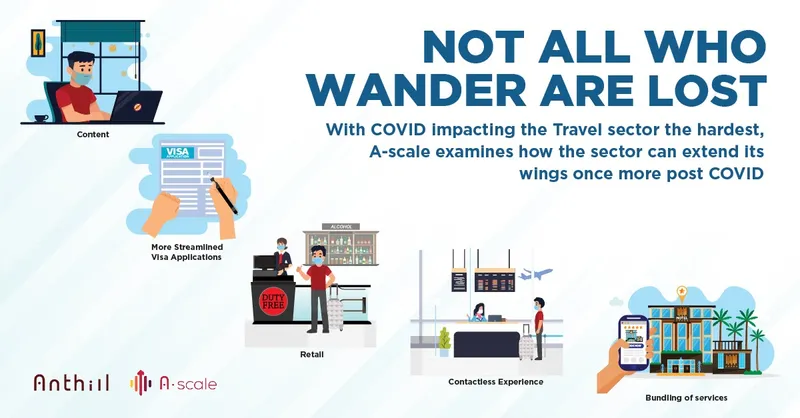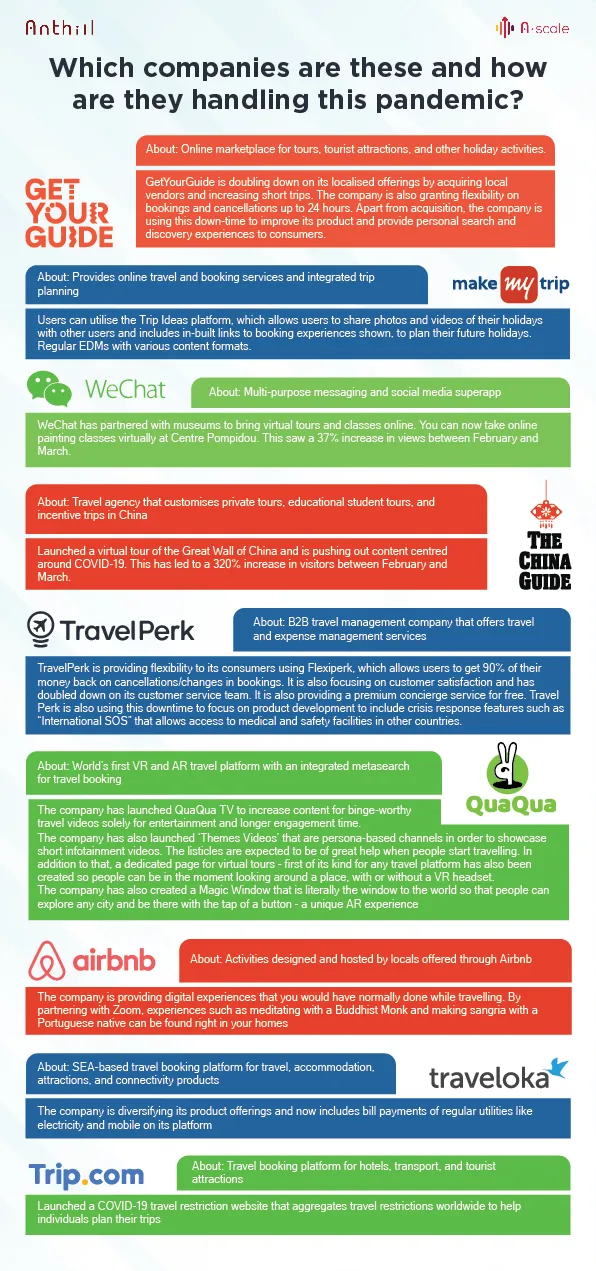How COVID-19 has impacted the travel sector and how the industry can mitigate the crisis
With COVID-19 hitting the travel sector the hardest, A-Scale examines how the sector can get back on its tracks once the crisis is over.

At A-Scale, we have a bird’s-eye view of different industries through our own portfolio companies and our interaction with other ecosystem partners. With the outbreak of COVID-19, many startups have been hurt by the crisis, yet it has also presented opportunities to others.
Recognising that we are all in the same boat, we’re attempting to provide our perspective on the impact COVID-19 has had on different industries in the form of quick facts, figures, and insights to help all members in the ecosystem tide over this difficult period together.
With the restrictions on travel and people becoming cautious to leave their homes, much less their countries, the travel and hospitality industry is one that has been hit the hardest due to COVID-19. Despite the dip that this industry is facing, every crisis, including the pandemic, comes with an opportunity.
For our first post, our goal is to see how even in this climate, the travel industry can shine.
COVID-19 and the TravelTech industry
With the rising number of cases, an increasing number of people have been cancelling their travel plans. Travel restrictions and the conservative approach of consumers to fly during this time has caused an average of 52 percent decline in bookings as compared to 2019.
This brings flashbacks of the state of the industry after the 9/11 attacks. Straight after the attacks, the demand for travel fell for five months. There was also a recession that followed these attacks, mirroring the current state of the global economy.
The industry eventually had a U-shaped recovery, with the US taking 45 months to recover fully. Looking at the data, we can say that COVID-19 may also follow a similar path, with domestic travel recovering faster than international.
Moving away from the areas affected by the virus to the one area that has made strides towards flattening the curve, there are lessons to be learnt from China. The industry in this part of the world is already on the path to recovery. It has rebounded to 30 percent of its normal levels after the lifting of the lockdown. Travellers in China are suffering from pent-up demand (or wanderlust), having spent almost three months in lockdown and are thus willing to spend more. 55 percent of bookings on Trip.com have been made at four- or five-star hotels, with a focus on the quality of services regarding hygiene.
A quick 10,000 feet view of some stakeholders presents the following:
Travel booking platforms
Online travel booking platforms have seen a huge dip in their bookings. This is also affecting the tour operators listed on these platforms. Out of one million total tour operators globally, 86 percent are small businesses (revenue <$250,000) with a short runway. This puts them at risk of being shut down if the situation persists, leading to a potential supply vacuum for experience providers upon the lifting of restrictions.
Airports
COVID-19 will also change consumers’ shopping behaviour at airports. Research shows that 39 percent of passengers would be less likely to spend time in stores at airports. This will present unique challenges for duty-free shops and other retailers to sell their products. 69 percent of passengers would prefer staying away from crowded areas and 35 percent of them would be less likely to touch or pick up items. Adding that the overall traffic at airports in India will see a 50–60 percent drop, retail stores at airports need to work with innovative solutions to mitigate this probable loss.
Customers
Consumer behaviour will transform with safety concerns and ease of travel becoming essential. A survey found that after COVID-19, consumers in China would prefer independent, self-guided and smaller group tours. In China, after the lifting of travel restrictions, it was found that tourists were only looking to travel domestically and were avoiding bus excursions and cruises.
Airlines
In April 2020, the International Civil Aviation Organisation (ICAO) estimated that global international passenger capacity had fallen by 91 percent. Air traffic also fell 77 percent from January to April, with carriers like easyJet and Austrian Airlines grounding their entire fleet. Nowadays, airports look more like drive-in theatres than nexuses of international commerce.
With all this doom and gloom, is there no hope for the travel industry? Not quite.
Post COVID-19 opportunities
In response to increasing demand for perceived virus-free experiences, TravelTech companies should consider providing safety-focused holiday planning and experiences. Demonstrating a commitment to high hygiene and safety standards of hotels and restaurants would assuage holiday-goers’ fears.
TravelTech companies can also tap the domestic travel market following the lifting of travel restrictions. As countries flatten the curve at differing rates, we anticipate a shift in consumer preferences towards domestic travel to avoid risks of infection in other countries. With India’s domestic travel market projected to be worth $48 billion in 2020, it is a sizable market to capture.
Some companies are already leading the way in riding out the COVID-19 wave.

With so many players already responding agilely to COVID-19, what could the future of travel hold? Let’s take a look at air travel.
Pre-travel
Content
With domestic travel opening up first, content in the travel space will need to get more local. This will necessitate a shift from content focusing on dream destinations such as Europe or Brazil to many different, local destinations catering to the new needs of domestic travellers.
This addition of destinations will require further large scale content generation leading to a rise in user-generated content. Concurrently, with users’ attention span shortening, such content will need to be in bite-size packages to cater to today’s “stories” generation.
More streamlined visa applications
Once COVID-19 abates, visa processing will see a flurry of activity with the clearing of backlogged applications and from individuals relocating and travelling for work. This is an opportunity for process innovation, namely through more efficient application and screening processes.
VFS Global launched their Visa At Your Doorstep service for Italian visa customers in 2019, which allows them to submit applications, documents, and enrol biometrics from any location of their choice. Potential exists here for machine learning applications to “pre-approve” or “score” visa applications and reduce the need for physical interaction.
Domestic transport
In India, we might also see a shift in people’s preference for travelling on flights over trains (second AC and above) domestically. Most travel straight after the lockdown will be essential travel. For these travellers, the duration of the journey and their safety will be of key concern. These reasons may lead to a shift in people’s preferences towards safer and faster journeys.
TravelTech companies that support booking of flights could market using these messages to further attract a new class of travellers.
At the airport
Enhanced screening
As human traffic picks up at airports, it becomes increasingly impractical to conduct temperature screening individually. Yet, a heightened safety standard is likely to demand the weeding out of febrile persons with a fine-toothed comb.
Solutions that use artificial intelligence to augment contemporary thermal scanning technologies, such as ’s iThermo in Singapore, will help bridge this gap. Companies that create cost-effective yet watertight screening solutions have the potential for significant market capture.
Retail
As people become more cautious about browsing at the airport, the time spent by travellers at duty-free stores will drastically decrease. In response, companies selling merchandise at airports will have to find ways to reach out to customers and make sales before they even enter the airports, making airports more of a pickup facility. This paves the way for innovative distribution technologies and strategies.
Lounges
Partnerships with lounges for lounge access may be more valued due to COVID-19. People will want to avoid crowded spaces once airports start functioning and would prefer waiting for their flights in more secluded areas. B2C TravelTech companies would have the unique opportunity to partner with lounges to provide additional benefits to their customers while responding to increased social distancing.
Contactless experiences
People are also becoming increasingly cautious and will look for a “zero-touch” experience at every step of their travel journey, especially in the months following the lifting of travel bans. This creates an opportunity for TravelTech companies to partner with large players (airports, airlines, etc) and co-create a contactless experience for these customers.
This could include robots at airports like Spencer at the Amsterdam airport that guides people to their seats and scans their boarding passes, or contactless biometrics and security screening.
Beyond the airport
Bundling of services
Due to the demand for hygiene and sanitation among consumers, TravelTech companies have the opportunity to certify COVID-ready vendors on their platform. By giving this special classification, the companies can also use the bundling strategy to give their users a complete COVID-safe travel experience.
Virtualisation
As the world adopts virtualisation of work, events, meetings and even large conferences, there is a large possibility that the trend will continue given the cost and efficiency of conducting such activities online. This will further affect travel and TravelTech companies will need to address this to capture consumers that may not travel due to this manner of virtualisation. This presents an opportunity for the fastest movers.
With all these opportunities available for TravelTech startups that can ride out COVID-19, these companies can truly innovate and come out stronger after the pandemic.
The world of travel today is eerily similar to what it was following the 9/11 attacks. Fear and subsequent austerity have brought travel to a near grinding halt. Confusion and uncertainty surround the industry, and a global economic slowdown is impending.
Travel, however, is in the very nature of what makes us human. From our ancestors braving rough seas to find new land to the global and interconnected citizens of today, travel truly makes the world go round. The travel industry will change, but humanity’s need and desire to travel will not. Startups and incumbents must take heart from this.
Just as the travel industry recovered and became more resilient after 9/11, with stronger security and changing business models, COVID-19 will necessitate innovators to rethink and revitalise the industry to create safer and more engaging experiences for us all.
We hope you enjoyed this report and would love to hear your thoughts on how COVID-19 will leave indelible imprints on the TravelTech industry!
Edited by Kanishk Singh
(Disclaimer: The views and opinions expressed in this article are those of the author and do not necessarily reflect the views of YourStory.)







